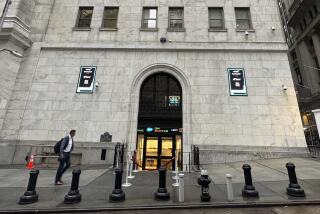FINANCIAL MARKETS : Program Trading Lifts Dow to Post-Crash High
NEW YORK — The stock market advanced to a new post-crash high Wednesday as investors carried the stock market’s rally through a seventh consecutive session.
The Dow Jones industrial average finished up 18.02 at 2,532.63, bringing its gain since the start of last week to 92.57.
Advancing issues outnumbered declines by about 4 to 3 in nationwide trading of New York Stock Exchange-listed stocks, with 844 up, 610 down and 539 unchanged.
Big Board volume totaled 160.55 million shares, down from 171.59 million Tuesday.
The market, which has advanced on expectations of falling interest rates and renewed takeover speculation, faltered earlier in the day. Traders said investors were growing cautious before June economic reports to be released Friday that could contain unpleasant surprises.
“I expected the market to be down today,” said trader John Burnett at Donaldson, Lufkin & Jenrette Securities. “The market just fooled everyone.”
Futures-related program trading kicked in late in the session to push the Dow index to a new post-crash closing high, past the June 23 finish of 2,531.87.
Essentially the rally has undone the damage from a weeklong selloff in late June that knocked 91 points off the index as investors worried about a possible recession.
Much of the demand was concentrated in blue chip issues, such as Procter & Gamble Corp. and Aluminum Co. of America, both components of the Dow industrial index. P&G; added 2 1/2 to 114 3/4 after it announced a 2-for-1 stock split Tuesday, and Alcoa finished up 1 1/2 at 66 1/4.
The market also received a boost from a futures-related “buy” program late in the session. “There was a very large program on the floor today and I could see it concentrated in a handful of stocks,” said market analyst Charles Jensen at MKI Securities.
Indeed, the market’s advance was not broadly enough based to reassure many analysts who worry that stocks may be vulnerable to a correction.
“The broad market does not really reflect an 18-point rise in the Dow,” Jensen said.
Many investors are waiting for Friday’s reports, which include the producer price and retail sales figures for June. Traders are betting that wholesale prices edged up 0.2% last month after advancing 0.9% in May, but a bigger rise could jolt the market.
Other gainers among the blue chips included International Business Machines, up 7/8 at 114 3/4; American Telephone & Telegraph, up 5/8 at 36 1/2; General Electric, up 1/2 at 54 3/8, and Union Carbide, up 5/8 at 27 1/8.
CBS Inc. added 7/8 to 210 1/2, joining 124 other NYSE issues at new 52-week highs although the company reported lower second-quarter earnings.
Airline issues pulled back a bit after a sharp rise of late fueled by takeover speculation. UAL fell 1 7/8 to 163 3/4, AMR dropped 1/2 to 62 1/4 and Delta Air Lines slipped 1 1/4 to 70.
Stock prices ended lower in slow trading on the Tokyo Stock Exchange. The 225-share Nikkei index, which gained 70.75 Tuesday, slipped 45.25 to close at 33,701.52.
In London, shares again ended at a post-crash high, as traders continued to ponder the repercussions of Tuesday’s $21-billion bid for BAT Industries. At the close, the Financial Times 100-share index was up 5.8 at 2,256.7.
Credit
Bond prices were mostly lower in dull trading.
The Treasury’s benchmark 30-year bond was down 5/32 point, or about $1.50 per $1,000 face amount. Its yield was unchanged at 8.03%, the same as late Tuesday.
Analysts said trading was extremely light in the absence of economic news to move the credit markets. They said a lower dollar helped depress bond prices slightly.
The federal funds rate, the interest on overnight loans between banks, traded at 9.313%, up from 9.188% late Tuesday.
Currency
The dollar drifted lower in quiet dealings as traders awaited Friday’s barrage of government data.
Currency dealers said profit taking and other internal market influences were largely responsible for the dollar’s decline.
However, trading was described as thin, with many dealers keeping a low profile until Friday’s release of government reports. The data will be scrutinized to determine whether the Federal Reserve will continue to loosen its credit policies by lowering interest rates to prevent the economy from falling into a recession, dealers say.
“After the news comes out the end of the week . . . I would say the Fed will err on the easier side,” said Ronald H. Holzer, chief dealer at Harris Trust & Co. in Chicago.
Lower interest rates tend to depress the dollar partly because they make dollar-denominated securities such as stocks and bonds less attractive to foreign investors, thereby decreasing the need to convert their currencies into dollars.
In Tokyo, where trading ends before Europe’s business day begins, the dollar rose 0.88 yen to a closing 140.50 yen. It was quoted at 139.85 yen in London and at 139.60 yen in New York, down from 140.75 Tuesday.
The dollar was mixed against the British pound. It cost $1.6255 to buy one pound in London, down from $1.6270 late Tuesday. Sterling fetched $1.6300 in New York, up from $1.6235.
Gold prices also declined. On the Commodity Exchange in New York, gold bullion for current delivery fell $2.80 to $378.70 an ounce. Republic National Bank of New York quoted a late bid of gold at $377.40, down from $379.
More to Read
Inside the business of entertainment
The Wide Shot brings you news, analysis and insights on everything from streaming wars to production — and what it all means for the future.
You may occasionally receive promotional content from the Los Angeles Times.










